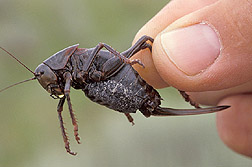This page has been archived and is being provided for reference purposes only. The page is no longer being updated, and therefore, links on the page may be invalid.
|
For Bands of Marching Crickets, It's a Bug-Eat-Bug World
By Erin PeabodyFebruary 28, 2006
Group living has its price. At least that’s the case for the millions of Mormon crickets that trekked together across the grasslands of southern Idaho last summer.
In observing this massive march, Agricultural Research Service (ARS) ecologist Gregory Sword and colleagues discovered that while the insects’ banding together shielded them from predatory birds and mammals, food deprivation brought on by a competition for certain nutrients led the crickets to cannibalism.
Researchers have long wondered what drives some insects, such as North America’s Mormon cricket and Africa’s desert locust, to move en masse. The team’s finding—that movement is propelled by the nutrient-starved insects themselves, literally nipping at each others’ heels out of hunger and out of fear of being eaten—is a completely novel explanation.
|
In the western United States, Mormon crickets can form up to six-mile-long bands, puzzling residents and pilfering crops and garden plants as they move across the landscape.
To better understand these bewildering and sometimes devastating swarms, Sword—who recently accepted a position with the University of Sydney in Australia—joined fellow researchers Stephen Simpson of the University of Sydney, Patrick Lorch of Kent State University in Ohio and Iain Couzin of the University of Oxford in the UK.
In the current study, the team discovered that marching crickets were deprived of two dietary necessities: protein and salt. In fact, when researchers placed petri dishes containing diets high in protein and salt in the face of an oncoming band, many of the crickets ceased moving to get access to them. They ignored dishes containing a carbohydrate diet.
Mormon crickets are known to cannibalize one another. But this phenomenon is now better explained since the insects are, after all, perfect packages of protein and salt.
The researchers' findings should lead to more environmentally-friendly tactics, including natural baits, for controlling large swarms of insects. The findings will appear this week in the online Early Edition of the Proceedings of the National Academy of Sciences.
ARS is the U.S. Department of Agriculture’s chief scientific research agency.


